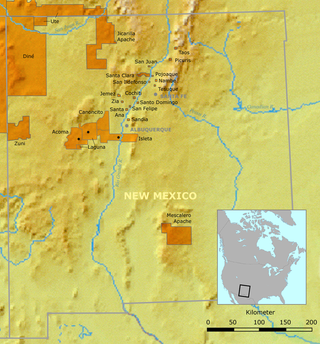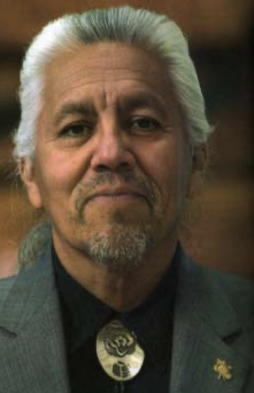
The Puebloans, or Pueblo peoples, are Native Americans in the Southwestern United States who share common agricultural, material, and religious practices. Among the currently inhabited Pueblos, Taos, San Ildefonso, Acoma, Zuni, and Hopi are some of the most commonly known. Pueblo people speak languages from four different language families, and each Pueblo is further divided culturally by kinship systems and agricultural practices, although all cultivate varieties of corn (maize).

Zia Pueblo is a census-designated place (CDP) in Sandoval County, New Mexico, United States. The population was 646 at the 2000 census, with 310 males and 336 females. The pueblo after which the CDP is named is included within the CDP; it is listed on the National Register of Historic Places.

The Zuni are Native American Pueblo peoples native to the Zuni River valley. The Zuni people today are federally recognized as the Zuni Tribe of the Zuni Reservation, New Mexico, and most live in the Pueblo of Zuni on the Zuni River, a tributary of the Little Colorado River, in western New Mexico, United States. The Pueblo of Zuni is 55 km (34 mi) south of Gallup, New Mexico. The Zuni tribe lived in multi level adobe houses. In addition to the reservation, the tribe owns trust lands in Catron County, New Mexico, and Apache County, Arizona. The Zuni call their homeland Halona Idiwan’a or Middle Place. The word Zuni is believed to derive from the Western Keres language (Acoma) word sɨ̂‧ni, or a cognate thereof.

Pueblo refers to the settlements and to the Native American tribes of the Pueblo peoples in the Southwestern United States, currently in New Mexico, Arizona, and Texas. The permanent communities, including some of the oldest continually occupied settlements in the United States, are called pueblos (lowercased).

Indigenous music of North America, which includes American Indian music or Native American music, is the music that is used, created or performed by Indigenous peoples of North America, including Native Americans in the United States and Aboriginal peoples in Canada, Indigenous peoples of Mexico, and other North American countries—especially traditional tribal music, such as Pueblo music and Inuit music. In addition to the traditional music of the Native American groups, there now exist pan-Indianism and intertribal genres as well as distinct Native American subgenres of popular music including: rock, blues, hip hop, classical, film music, and reggae, as well as unique popular styles like chicken scratch and New Mexico music.

Jicarilla Apache, one of several loosely organized autonomous bands of the Eastern Apache, refers to the members of the Jicarilla Apache Nation currently living in New Mexico and speaking a Southern Athabaskan language. The term jicarilla comes from Mexican Spanish meaning "little basket", referring to the small sealed baskets they used as drinking vessels. To neighboring Apache bands, such as the Mescalero and Lipan, they were known as Kinya-Inde.
New Mexico is a state of the Southwest United States. The state has music traditions dating back to the ancient Anasazi and Pueblo people, Navajo, Apache, and the Spanish Santa Fe de Nuevo México; these old traditions are found in both their original folk forms and as a modern folk genre known as New Mexico music.

The Zia or Tsʾíiyʾamʾé are an indigenous nation centered at Zia Pueblo (Tsi'ya), a Native American reservation in the U.S. state of New Mexico. The Zia are known for their pottery and use of the sun symbol. They are one of the Keres Pueblo peoples and speak the Eastern Keres language.

Sandia Pueblo is a federally recognized tribe of Native American Pueblo people inhabiting a 101-square-kilometre (40 sq mi) reservation of the same name in the eastern Rio Grande Rift of central New Mexico. It is one of 19 of New Mexico's Native American pueblos, considered one of the state's Eastern Pueblos. The population was 427 as of the 2010 census. The people are traditionally Tiwa speakers, a language of the Tanoan group, although retention of the traditional language has waned with later generations. They have a tribal government that operates Sandia Casino, Bien Mur Indian Market Center, and Sandia Lakes Recreation Area, as well as representing the will of the Pueblo in business and political matters.

Robert Mirabal is a Pueblo musician and Native American flute player and maker from Taos Pueblo, New Mexico.

The Pueblo of Laguna, New Mexico is a federally recognized tribe of Native American Pueblo people in west-central New Mexico, near the city of Albuquerque, in the United States. Part of the Laguna territory is included in the Albuquerque metropolitan area, chiefly around Laguna's Route 66 Resort and Casino. The name, Laguna, is Spanish and derives from the lake on their reservation. This body of water was formed by an ancient dam that was constructed by the Laguna people. After the Pueblo Revolt of 1680–1696, the Mission San José de la Laguna was erected by the Spanish at the old pueblo and finished around July 4, 1699.

The Gathering of Nations is the largest pow-wow in the United States and North America. It is held annually on the fourth weekend in April, on the Powwow Grounds at Expo NM, in Albuquerque, New Mexico. Over 565 tribes from around the United States and 220 from Canada travel to Albuquerque to participate.
Pura Fé (Tuscarora/Taino) was born Pura Fé Antonia "Toni" Crescioni) is singer-songwriter, musician, story teller, instructor, seamstress, artist and a founding member of the Native Women's a cappella trio Ulali.
Jeff Carpenter is a musician and songwriter with the all Native American orchestral rock band Injunuity.
Tammy Garcia is a Santa Clara Pueblo sculptor and ceramic artist. Garcia translates Pueblo pottery forms and iconography into sculptures in bronze and other media.

New Mexico music is a genre of music that originated in the US state of New Mexico. It derives from Pueblo music in the 13th century, and with the folk music of Hispanos during the 16th to 19th centuries in Santa Fe de Nuevo México.

David Joseph Shelley was an American blues rock musician who performed with Cher and released two critically acclaimed albums, That's My Train (2012) and Trick Bag (2013).
Elizabeth Toya Medina is a Pueblo potter. She married into the Zia tribe in 1978 and, as is traditional, gained tribal permission to use Zia designs in her work. Her first pots were in the Jemez style. In some instances she has collaborated with her mother-in-law, Sofia Medina, whom she cites as her inspiration.

Pueblo pottery are ceramic objects made by the Indigenous Pueblo people and their antecedents, the Ancestral Puebloans and Mogollon cultures in the Southwestern United States and Northern Mexico. For centuries, pottery has been central to pueblo life as a feature of ceremonial and utilitarian usage. The clay is locally sourced, most frequently handmade, and fired traditionally in an earthen pit. These items take the form of storage jars, canteens, serving bowls, seed jars, and ladles. Some utility wares were undecorated except from simple corrugations or marks made with a stick or fingernail, however many examples for centuries were painted with abstract or representational motifs. Some pueblos made effigy vessels, fetishes or figurines. During modern times, pueblo pottery was produced specifically as an art form to serve an economic function. This role is not dissimilar to prehistoric times when pottery was traded throughout the Southwest, and in historic times after contact with the Spanish colonialists.

Joe A. Garcia, also known as Sokuwa Owing Taa', was a Native American leader from the US state of New Mexico. A former governor of the Ohkay Owingeh pueblo, he served as president of the National Congress of American Indians (NCAI) for two terms, from 2005 to 2009. He also served as chairman of the All Indian Pueblo Council. From 2009 onward, he was head councilman of the Ohkay Owingeh, formerly known as the San Juan Pueblo. An electrical engineer by profession, Garcia worked at Los Alamos National Laboratory for 25 years, retiring in 2003. He was also a singer-guitarist for the country music band Jed, and performed in the first Native Roots & Rhythms Festival in New Mexico in 1995.















